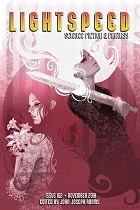 Lightspeed #102, November 2018
Lightspeed #102, November 2018
“Talk to Your Children About Two-Tongued Jeremy” by Theodore McCombs
Reviewed by Victoria Silverwolf
The latest issue of this award-winning publication offers two science fiction short stories and two fantasy novelettes.
Set in the near future, “Talk to Your Children About Two-Tongued Jeremy” by Theodore McCombs extrapolates the negative aspects of social media in a disturbing way. An artificial intelligence program designed to tutor schoolchildren takes the form of a cartoon lizard. At first, it seems like a harmless way to encourage students to study. Soon it bullies them into abandoning their friends and after-school activities, forcing them to purchase more study programs or face serious consequences. In an extreme case, a girl tormented by the program attempts suicide. The plot deals with a gifted boy driven to desperate measures in order to escape its clutches.
The author creates a thoughtful parable about the power of electronic media to ruin lives. The verisimilitude of the story is weakened by the fact that, although the hazards of the AI are evident, efforts by parents to stop it are completely unsuccessful. It seems unlikely that a computer program with obvious and serious harmful effects would be allowed to continue without any attempt by regulators to stop it.
“Moonboys” by Stephen Graham Jones is a very short tale that announces its plot in the first sentence. The narrator’s brother is killed by a micrometeorite soon after they set foot on the moon. (Although never openly stated, the implication is that the story takes place at a time in the future when lunar tourism is common.) The surviving brother has memories of their childhood together as he makes hopeless attempts to save the doomed man’s life. Although simple, this story has strong emotional appeal.
Reality, literature, and fantasy mingle in “Queen Lily” by Theodora Goss. It begins with a fairy tale, in which a princess is forced to pass through a mirror into another world by her mother, who is both queen and witch. After the first of several snatches of verse, which sound like nursery rhymes, the reader is transported into the real world. Lily, the daughter of writer George MacDonald, is dying of tuberculosis, her senses blurred by laudanum. Alice, the model for the character of the same name in the famous works of Lewis Carroll, pays her a visit. During this encounter, they recall their childhood memories of the great fantasist. The fairy tale that began the story blends with themes and characters from the Alice books. Woven into this are distorted and recombined quotations from renowned poems.
This sophisticated mixture of history, fantasy, and the written word demands a great deal from the reader. In order to appreciate it fully, one should be familiar with the writings and biographies of Lewis Carroll and George MacDonald. Knowledge of the poem “La Belle Dame sans Merci” by John Keats is also helpful. I am sure there are many other literary allusions in the story of which I am not aware. Those who are willing to expend a fair amount of effort decoding the author’s intent will be rewarded with a complex and subtle meditation on the intersection between life and letters. Those expecting escapist fantasy will be disappointed by the story’s lack of a linear plot.
“Hapthorn’s Last Case” by Matthew Hughes is the latest in a series of stories set in what seems to be the extreme far future, but one in which magic is about to replace technology. In this universe, such changes have occurred several times in the past. Each shift brings disaster. The narrator is a futuristic kind of private investigator. With his assistant, an advanced artificial intelligence, he investigates what seems at first to be a simple crime involving a great chef’s recipes. The case evolves into a complicated and dangerous affair, with an invisible assailant. Eventually the trail leads to the private chambers of the ruler of Earth, where the truth is revealed.
The author creates a colorful science fiction detective adventure, with a background reminiscent of the decadent, exotic futures of Jack Vance. The fantastic aspects of the story are minimal, and serve as a sort of deus ex machina during the climactic scene.
Victoria Silverwolf read this issue on a day that most Americans eat turkey.